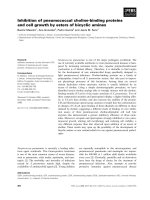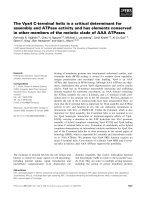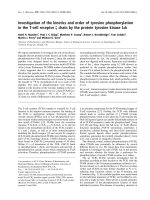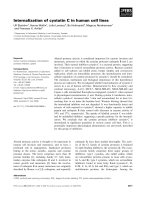Báo cáo khoa học: "Thickness of cumulus cell layer is a significant factor in meiotic competence of buffalo oocytes" potx
Bạn đang xem bản rút gọn của tài liệu. Xem và tải ngay bản đầy đủ của tài liệu tại đây (52.39 KB, 5 trang )
-2851$/ 2)
9H W H U L Q D U \
6FLHQFH
J. Vet. Sci.
(2004),
/
5
(3), 247–251
Thickness of cumulus cell layer is a significant factor in meiotic competence
of buffalo oocytes
Hassan M. Warriach
1
, Kazim R. Chohan
2,
*
1
Department of Theriogenology, Faculty of Veterinary Sciences, University of Veterinary and Animal Sciences,
Lahore 54000, Pakistan
2
Andrology and IVF Laboratories, School of Medicine, University of Utah, 675 Arapeen Drive, Suite 205, Salt Lake City, UT 84108,
USA
This study evaluated the meiotic competence of buffalo
oocytes with different layers of cumulus cells. A total of
588 oocytes were collected from 775 ovaries averaging
0.78 oocytes per ovary. Oocytes with homogenous
cytoplasm (n = 441) were selected for
in vitro
maturation
(IVM) and divided into four groups based on their
cumulus morphology: a) oocytes with
≥
= 3 layers of
cumulus cells, b) 1-2 layers of cumulus cells and oocytes
with partial remnants or no cumulus cells to be co-
cultured c) with or d) without cumulus cells. Oocytes in all
four groups were matured in 100
µ
L drop of TCM-199
supplemented with 10
µ
g/mL follicle stimulating hormone
(FSH), 10
µ
g/mL luteinizing hormone (LH), 1.5
µ
g/mL
estradiol, 75
µ
g/mL streptomycin, 100 IU/mL penicillin,
10 mM Hepes and 10% FBS at 39
o
C and 5% CO
2
for 24
hours. After IVM, cumulus cells were removed from
oocytes using 3 mg/mL hyaluronidase, fixed in 3%
glutaraldehyde, stained with DAPI and evaluated for
meiotic competence. The oocytes with
≥
=3 layers of
cumulus cells showed higher maturation rates (
p
<0.05:
64.5%) than oocytes with partial or no cumulus cells
(8.6%) and oocytes co-cultured with cumulus cells
(34.5%) but did not differ from oocytes having 1-2 layers
of cumulus cells (51.4%). The degeneration rates were
higher (
p
< 0.05) for oocytes with partial or no cumulus
cells (51%) than rest of the groups (range: 13.8% to
17.4%). These results suggest that buffalo oocytes with
intact layers of cumulus cells show better IVM rates than
oocytes without cumulus cells and the co-culture of poor
quality oocytes with cumulus cells improves their meiotic
competence.
Key words:
buffalo, oocyte, cumulus, IVM
Introduction
The successful
in vitro
maturation, fertilization, and
culture (IVM/IVF/IVC) of bovine oocytes has brought
interest to implement this technique in water buffalo
(Bubalis bubalis) for
in vitro
production of embryos. The
inherent problem of low oocyte yields from buffalo ovary
[8,11,27,32] makes the use of IVF procedures questionable
given the cost of IVF and low oocyte yield. This poor oocyte
yield has been attributed to low number of primordial
follicles (10,000 to 19,000) in the buffalo ovary [10,26]
compared to 150,000 in cattle [14]. Despite this major
factor, high rates of 70-90% for IVM [4,8,17,22], 60-70%
for IVF [8,17,21,33] and 40-50% for cleavage rate [5,17,20,
21] have been observed. However, blastocyst development is
still very poor and ranges between 10-30% [3,4,6,21,23].
The number and quality of oocytes further decreases during
summer months [22,29] allowing fewer oocytes available
for IVF studies. Considering the low yield of oocytes from
the buffalo ovary, this investigation was carried out to utilize
all the available oocytes with homogenous cytoplasm with
varying layers of cumulus cells for IVM.
Materials and Methods
This study was conducted during the months of July and
August when minimum temperature varied between 27
o
C
(80.6
o
F) to 32
o
C (89.6
o
F) and maximum temperature varied
between 31
o
C (87.8
o
F) to 37
o
C (98.6
o
F). The relative
humidity varied between 66 to 89% during trial period.
Unless specified, the reagents were from Sigma Chemicals
(St. Louis, MO, USA).
Collection of oocytes
Ovaries from adult buffalos of Nili-Ravi breed were
collected immediately after slaughter and transported to the
laboratory within two hours of collection in an insulated
container at 35-37
o
C. Upon arrival, ovaries were washed
twice with normal saline containing 100 IU/mL of penicillin
*Corresponding author
Phone: +1-801-587-3706; Fax: +1-801-581-6127
E-mail:
248 Hassan M. Warriach, Kazim R. Chohan
and 100
µ
g/mL of streptomycin. Oocytes were aspirated
from 2-8 mm follicles with an 18-gauge needle fitted to a
12 mL disposable syringe and transferred to 15 mL
polystyrene centrifuge tubes in a 37
o
C water bath. Oocytes
were recovered from the settled sediment after 15-20
minutes using a low power (20X) stereomicroscope. The
data regarding number of ovaries used, number of oocytes
collected, quality of the oocytes and the number of oocytes
used in each replicate was recorded.
In vitro
maturation of oocytes
Oocytes with homogenous cytoplasm were divided into
four groups based on their cumulus morphology: a) oocytes
with
≥
= 3 layers of cumulus cells, b) 1-2 layers of cumulus
cells and oocytes with partial remnants or no cumulus cells
to be co-cultured c) with or d) without cumulus cells.
Oocytes in all four groups were washed thrice in medium
199 and transferred to 100
µ
L droplets (5-8 oocytes/drop) of
maturation medium (TCM-199: Gibco Life Technologies,
NY, USA) under sterile mineral oil in plastic dishes and
incubated at 39
o
C and 5% CO
2
in air for 24 hours. The
maturation medium was supplemented with 10
µ
g/mL FSH,
10
µ
g/mL LH, 1.5
µ
g/mL estradiol, 75
µ
g/mL streptomycin,
100 IU/mL penicillin, 10 mM Hepes, and 10% fetal bovine
serum (FBS: Hyclone Laboratories Inc. Logan, UT, USA).
Freshly detached cumulus cells were washed twice by
centrifugation at 300 g in maturation medium and 1-
1.2
×
10
6
/mL cells were added to each microdrop of
maturation medium in the co-culture group.
Evaluation for meiotic development
After IVM, oocytes in all groups were exposed to 3 mg/
mL hyaluronidase in saline and cumulus cells were removed
by repeated pipetting. Denuded oocytes were fixed in 3%
glutaraldehyde in saline at room temperature for 15 minutes,
rinsed and incubated in 0.001% 4, 6 diamidoino-2-
phenylindole (DAPI), a fluorescent stain specific for nuclear
material for 20 minutes at room temperature. Oocytes were
rinsed in saline to remove DAPI particles, mounted on glass
slides, and evaluated for meiotic development (oocytes
reaching metaphase-II) at 400x using a Nikon microscope
equipped with fluorescent illumination and filters giving
maximum transmittance at 405 nm. An oocyte was
classified as degenerated if the nuclear material was
scattered in the ooplasm indicating spindle damage.
Statistical analysis
Data for meiotic development of oocytes among all
groups was analyzed by chi square procedure using Statistix
Analytical Software, Tallahassee, FL, USA.
Results
A total of 588 oocytes were aspirated from 755 ovaries in
nine replicates of which 441 oocytes with homogenous
cytoplasm and varying layers of cumulus cells were used for
IVM while the remaining were used for cumulus cells or
discarded due to poor quality. The number of oocytes
collected averaged 0.78 per ovary (Table 1). The IVM rates
for oocytes with
≥
= 3 layers (64.5%) and 1-2 layers of
cumulus cells (51.4%) were significantly (
p
< 0.05) higher
than oocytes with partial remnants or without cumulus cells
(8.6%) and oocytes co-cultured with cumulus cells (34.5%).
No difference was observed for IVM rates between oocytes
having
≥
= 3 and 1-2 layers of cumulus cells. The
degeneration rates were higher (
p
< 0.05) for oocytes without
cumulus cells (51%) than all the other groups (Table 2).
Discussion
Cumulus cells have been considered to play an important
role in oocyte maturation by keeping the oocyte under
meiotic arrest, inducing meiotic resumption and by
supporting cytoplasmic maturation. These functions have
been attributed to their gap junctions and their specific
metabolizing capabilities [31]. Physical contact between
Table 1.
Oocyte yield and quality of oocytes collected from buffalo ovaries
Replicate
Number
Total
Ovaries
Total
Oocytes
Oocytes with =3
layers cumulus cells
Oocytes with 1-2
layers cumulus cells
Oocytes with partial
or no cumulus cells
1 70 56 (0.80) 14 (0.20) 12 (0.17) 30 (0.42)
2 102 82 (0.80) 22 (0.21) 20 (0.19) 40 (0.39)
3 88 72 (0.81) 22 (0.25) 20 (0.22) 30 (0.34)
4 82 66 (0.80) 18 (0.21) 16 (0.19) 32 (0.39)
5 68 53 (0.77) 18 (0.26) 15 (0.22) 20 (0.29)
6 83 51 (0.61) 14 (0.17) 12 (0.14) 25 (0.30)
7 89 66 (0.74) 17 (0.19) 16 (0.18) 33 (0.37)
8 102 82 (0.80) 19 (0.18) 20 (0.19) 43 (0.42)
9 71 60 (0.85) 22 (0.31) 17 (0.24) 21 (0.30)
Total 755 588 (0.78) 166 (0.22) 148 (0.20) 274 (0.36)
Numbers in parenthesis are average number of oocytes collected per ovary in respective group.
Meiotic competence of buffalo oocytes 249
oocyte and cumulus cells has been considered necessary for
the transfer of nutrients and factors essential for oocyte
development [2]. However, dissociated cumulus cells have
been reported to produce paracrine factors, which resume
meiosis in denuded oocytes [13]. The results of this study
showed that buffalo oocytes with homogenous cytoplasm
surrounded by compact layers of cumulus cells had a
significantly higher maturation rate than oocytes with partial
remnants or no cumulus cells matured with or without
additional cumulus cells. The modest increase in IVM rates
of co-cultured oocytes in this study can be justified by the
fact that paracrine factors produced by the added cumulus
cells might have been only transferred to partially denuded
oocytes via available gap junctions whereas such
communication seems absent in similar oocytes matured
without cumulus cells. This is also evident from the results
that addition of cumulus cells not only improved IVM but
also rescued oocytes from degeneration whereas more
oocytes without somatic cell support underwent degeneration.
Present study yielded 0.78 oocytes per ovary, which is low
compared to previous findings of 1.49 [8] and 1.76 [27] for
the same breed of buffalo. This difference in oocyte yield is
due to seasonal variation because the other studies were
conducted during the cooler months of winter. Fewer
follicles were found on buffalo ovaries at slaughter during
summer than winter months [25] and buffaloes under heat
stress produced fewer good quality oocytes than unstressed
buffaloes [29]. The number of oocytes decreased from 1.7 to
0.9 [11] and from 0.7 to 0.4 [32] per ovary when selected for
IVM on the basis of cumulus morphology. These findings
are in agreement to cumulative number of 0.42 oocytes per
ovary recovered with
≥
= 3 and 1-2 layers of cumulus cells
in present study. Datta and Goswami [9] observed a
significant drop from 1.02 to 0.84 in oocyte yield and a
decrease from 0.21 to 0.14, 0.45 to 0.33 and 0.46 to 0.35 for
good, average and poor quality oocytes per ovary in buffalo
when temperatures increased from <25
o
C to >25
o
. Nandi
et
al
. [22] also found a decline from 1.22 to 0.85 oocytes per
ovary when oocytes were collected during cool (1-10
o
C) and
hot (> 30
o
C) months, respectively. Their IVM rates also
differed between cool (89%) and hot (72%) seasons but no
difference was observed for fertilization, cleavage and
blastocyst development because only matured oocytes were
used for IVF/IVC. A marked decrease in oocyte yield,
quality and developmental ability has been also reported in
Bos taurus cows [24].
Our IVM rates for oocytes with
≥
= 3 and 1-2 layers of
cumulus cells are lower than IVM rates of 84-91%
previously reported for the same breed of buffalo [8]. This
difference is due to season as well as the use of quality
oocytes. In a previous study, Chauhan
et al
. [4] found
significantly different IVM rates of 85, 54, and 26% for
grade 1 (
≥
= 5 layers of cumulus cells and homogenous
cytoplasm), grade 2 (
≤
= 4 layers of cumulus cells and
homogenous cytoplasm) and grade 3 (without cumulus cells
and irregular shrunken cytoplasm) buffalo oocytes. The
subsequent fertilization, cleavage and blastocyst rates were
also different in relation to the quality of the oocytes and no
blastocyst was formed from grade 3 oocytes. They
suggested that the embryo yield can be predicted after
IVMFC by gross morphological appearance of the aspirated
oocytes and grade 2 oocytes can be effectively used in
buffalo IVF system however their paper lacks the
information about the season of study which is a critical
factor in buffalo reproduction. Similar observations were
recorded for good, fair, and poor quality oocytes in Egyptian
buffaloes [1]. Though buffaloes cycle throughout the year,
they show a very significant seasonality in breeding that
only 4% come into estrus from April through July [18].
Considering the low availability of quality oocytes from
buffalo ovary, attempts have been made to utilize the oocytes
recovered in denuded form during aspiration in an IVF
system. In a previous study [12], addition of cumulus cells in
maturation medium restored the nuclear maturation of
Table 2.
In vitro
maturation of buffalo oocytes with varying layers of cumulus cells
Groups Oocytes
GV GVBD Metaphase-I Metaphase-II Degenerated
Percentage
Oocytes with
≥
=3 layers
of cumulus cells
118 4.2
a
(5) 6.8
ab
(8) 10.2
a
(12) 64.5
a
(76) 14.4
a
(17)
Oocytes with 1-2 layers
of cumulus cells
103 10.6
ab
(11) 4.9
a
(5) 15.6
ac
(16) 51.4
a
(53) 17.4
a
(18)
Oocytes with partial or
no cumulus cells
104 10.6
ab
(11) 14.4
b
(15) 15.4
ac
(16) 8.6
b
(9) 51.0
b
(53)
Oocytes with partial or
no cumulus cells +
cumulus cells
116 15.5
b
(18) 14.6
b
(17) 21.6
bc
(25) 34.5
c
(40) 13.8
a
(16)
abcd = Denote differences with in columns (
p
< 0.05) by Chi square.
Numbers in parenthesis show the number of oocytes.
GV = Germinal vesicle, GVBD = Germinal vesicle break down.
250 Hassan M. Warriach, Kazim R. Chohan
artificially denuded oocytes (64%) close to the compact
cumulus enclosed oocytes (66%) but oocytes recovered in
denuded form (46%) never reached the same levels of IVM.
In another study [30], buffalo oocytes with compact and
dense cumulus cells showed higher IVM rate (
p
< 0.01:
67.3%) than oocytes with thin cumulus layer (27.5%) or
with small remnants of cumulus cells and poor naked
oocytes (3%). These findings are in agreement to present
results but again lack the information about season of study.
Lower IVM and IVF rates have been also reported for
cumulus free oocytes compared to cumulus enclosed
oocytes in cattle [7,15,19,28,34].
In summary, the results of present study suggest that
nuclear maturation can be restored in a substantial number
of buffalo oocytes recovered in denuded form or with partial
remnants of cumulus cells by addition of cumulus cells in
maturation medium. However, further studies are required to
understand the cytoplasmic maturation of such oocytes,
which is essential for male pronucleus formation and
subsequent embryonic development. We also suggest that
IVM/IVF/IVC procedures in water buffalo should be
preferably performed during the cool months of winter and
season of experiment be reported in publications. Our
understanding is that the studies on abattoir ovaries may not
be truly representative of the potential of the buffalo ovary as
mostly aged, underfed and post lactation animals are
slaughtered. Therefore, further studies should be focused on
IVMFC of oocytes recovered by ultrasound guided
transvaginal aspiration from young live animals in good
body condition.
Acknowledgments
Authors thank Dr. Alan G. Hunter, Professor of Animal
Physiology, Department of Animal Science, University of
Minnesota, Saint Paul, USA and Dr. Muhammad Aleem
Bhatti, Associate Professor, Department of Theriogenology,
University of Veterinary and Animal Sciences, Lahore,
Pakistan for their support.
References
1. Abdoon AS, Kandil OM, Otio T, Suzuki T. Influence of
oocyte quality, culture media and gonadotrophins on
cleavage rate and development of
in vitro
fertilized buffalo
embryos. Anim Reprod Sci 2001, 65, 215-223.
2. Albertini DF, Combelles CM, Benecchi E, Carabatsos
MJ. Cellular basis for paracrine regulation of ovarian follicle
development. Reproduction 2001, 121, 647-653.
3. Chauhan MS, Katiyar PK, Madan ML.
In vitro
production
of blastocyst in goats, sheep and buffaloes. Indian J Anim Sci
1997, 65, 394-396.
4. Chauhan MS, Singla SK, Palta P, Manik RS, Madan ML.
In vitro
maturation and fertilization, and subsequent
development of buffalo (Bubalis bubalis) embryos: effects of
oocyte quality and type of serum. Reprod Fertil Dev 1998,
10, 173-177.
5. Chauhan MS, Katiyar PK, Singla SK, Manik RS, Madan
ML. Production of buffalo calves through
in vitro
fertilization. Indian J Anim Sci 1998, 67, 306-308.
6. Chauhan MS, Singla SK, Palta P, Manik RS, Tomer OS.
Development of
in vitro
produced buffalo (
Bubalis bubalis
)
embryos in relation to time. Asian Aust J Anim Sci 1998, 11,
398-403.
7. Chian RC, Okuda K, Niwa K. Influence of cumulus cells
on
in vitro
fertilization of bovine oocytes. Anim Reprod Sci
1995, 38, 37-48.
8. Chohan KR, Hunter AG.
In vitro
maturation and
fertilization of water buffalo oocytes. Buffalo J 2003, 19, 91-
101.
9. Datta TK, Goswami SL. Feasibility of harvesting oocytes
from buffalo (
Bubalis bubalis
) ovaries by different methods.
Buffalo J 1998, 14, 277-284.
10. Danell B. Oestrus behavior, ovarian morphology and cyclical
variation in the follicular system and endocrine pattern in
water buffalo heifers. PhD Thesis. 1987, Swedish Univ. Agri.
Sci. Uppsala, Sweden.
11. Das SK, Chauhan MS, Palta P. Replacement of fetal bovine
serum and FSH with buffalo follicular fluid in
in vitro
maturation of buffalo oocytes. Theriogenology 1996, 45,
245.
12. Das SK, Chauhan MS, Palta P, Tomer OS. Influence of
cumulus cells on
in vitro
maturation of denuded buffalo
oocytes. Vet Rec 1997, 141, 522-523.
13. Downs SM. A gap junction-mediated signal predominates
during meiotic induction in mouse. Zygote 2001, 9, 71-82.
14. Erickson BH. Development and senescence of the postnatal
bovine ovary. J Anim Sci 1966, 25, 800-805.
15. Fukui Y, Sakuma Y. Maturation of bovine oocytes cultured
in vitro
: Relation to ovarian activity, follicular size and
presence or absence of cumulus cells. Biol Reprod 1980, 22,
669-673.
16. Ganguli G, Indra A, Gupta P. Suitability of follicular
oocytes obtained from slaughtered buffalo ovaries and
assessment of their nuclear maturation. Buffalo J 1998, 14,
217-227.
17. Gupta SP, Nandi S, Ravindaranatha BM, Sharma VP.
Effect of commercially available PMSG on maturation,
fertilization and embryo development of buffalo oocytes
in
vitro
. Reprod Fert Dev 2001, 13, 355-360.
18. Ishaq SM. Breeding habits of buffalo cows. The Healer
(Annual magazine for the College of Veterinary Sciences,
Lahore, Pakistan). 1957, 26-28.
19. Leibfried-Rutledge ML, Cristser ES, Parrish JJ, First
NL.
In vitro
maturation and fertilization of bovine oocytes.
Theriogenology 1989, 31, 61-74.
20. Madan ML, Singla SK, Chauhan MB, Manik RS.
In vitro
production and transfer of embryos in buffaloes.
Theriogenology 1994, 41, 139-143.
21. Nandi S, Chauhan MS, Palta P. Influence of cumulus cells
and sperm concentration on cleavage rate and subsequent
embryonic development of buffalo (Bubalus bubalis) oocytes
matured and fertilized
in vitro
. Theriogenology 1998, 50,
Meiotic competence of buffalo oocytes 251
1251-1262.
22. Nandi S, Chauhan MS, Palta P.
Effect of environmental
temperature on quality and developmental competence of
buffalo oocytes. Vet Rec 2001,
148
, 278-279.
23. Raghu HM, Nandi S, Reddy SM.
Follicle size and oocyte
diameter in relation to developmental competence of buffalo
oocytes
in vitro
. Reprod Fertil Dev 2002,
14
, 55-61.
24. Rocha A, Randel RD, Broussard JR, Lim JM, Blair RM,
Roussel JD, Godke RA, Hansel W.
High environmental
temperature and humidity decrease oocyte quality in Bos
tauraus but not in Bos indicus cows. Theriogenology 1998,
49
, 657-665.
25. Roy DT, Bhattacharya AR, Luktuke SN.
Estrus and
ovarian activity of buffaloes in different months. Indian Vet J
1972,
49
, 54-60.
26. Samad HA, Nasseri AA.
A quantitative study of primordial
follicles in buffalo heifer ovaries. In: Comp. 13th FAO/SIDA
Int. Course on Animal Reproduction, Uppsala, Sweden,
1979.
27. Samad HA, Khan IQ, Rehman NU, Ahmad N.
The
recovery,
in vitro
maturation and fertilization of Nili-Ravi
buffalo follicular oocytes. Asian Aus J Anim Sci 1998,
11
,
491-497.
28. Shioya Y, Kuwayama M, Fukushima M, Iwasaki, S.
In
vitro
fertilization and cleavage capability of bovine follicular
oocytes classified by cumulus cells and matured
in vitro.
Theriogenology 1988,
30
, 489-494.
29. Singla SK, Manik RS, Chauhan MS, Madan ML.
Quality
of oocytes obtained from buffalo ovaries during winter and
summer months. Indian J Anim Reprod 1999,
20
, 100-102.
30. Suzuki T, Singla SK, Sujata T, Madan ML.
In vitro
fertilization of water buffalo follicular oocytes and their
ability to cleave
in vitro
. Theriogenology 1992,
38
, 1187-
1194.
31. Tanghe S, Soom AV, Nauwynck H, Coryn M, DeKruif A.
Minireview: Functions of the cumulus ophorous during
oocyte maturation, ovulation and fertilization. Mol Reprod
Dev 2002,
61
, 414-424.
32. Totey SM, Singh G, Taneja M, Pawshe CH, Talwar GP
.
In
vitro
maturation, fertilization and development of follicular
oocytes from buffalo. J Reprod Fertil 1992,
95
, 597-607.
33. Totey SM, Pawshe CH, Singh GP.
In vitro
maturation and
fertilization of buffalo oocytes (Bubalis bubalis): Effects of
media, hormones and sera. Theriogenology 1993,
39
, 1153-
1171.
34. Zhang L, Jiang S, Wozniak PJ, Yang X, Godke RA.
Cumulus cell function during bovine oocytes maturation,
fertilization, and embryo development
in vitro
. Mol Reprod
Dev 1995,
40
, 338-344.









